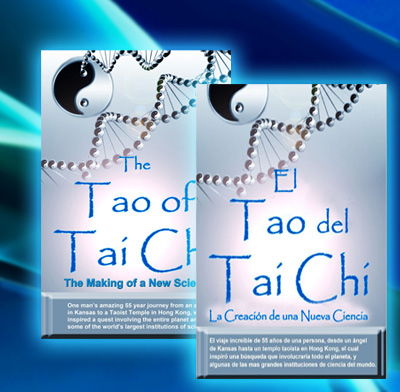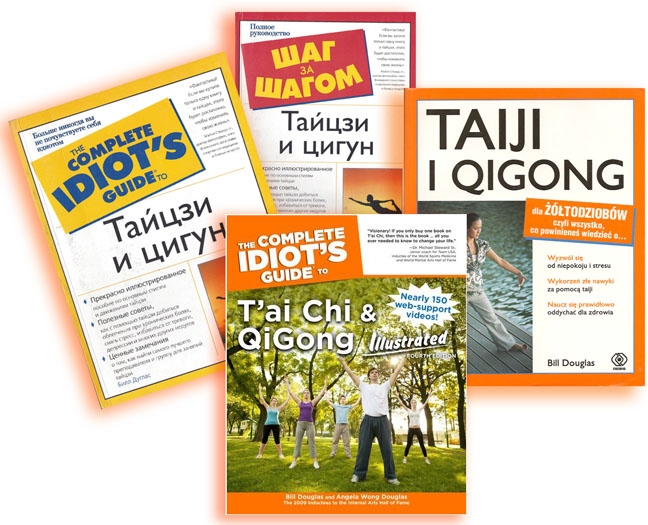Bone loss / bone density and Tai Chi & qigong
BONE LOSS / BONE DENSITY and QIGONG / TAI CHI!
NIH (National Institutes of Health) Research
CONCLUSION:
This is the first case-control study to show
that regular Tai Chi Chuan exercise may help retard bone loss
in the weight-bearing bones of postmenopausal women.
http://www.ncbi.nlm.nih.gov/pubmed/12370867
Medscape: BRITTLE BONE/BONE LOSS
Tai Chi is a promising
intervention for maintaining postmenopausal women's bone
mineral density. No significant adverse effects of practicing
Tai Chi were reported, and research also indicates that Tai
Chi may improve other risk factors associated with low bone
mineral density. Therefore, more research needs to be
conducted.- Medscape Today, from WebMD, 10/26/2010
Low bone density. A review of six controlled studies
by Dr. Wayne and other Harvard researchers indicates that tai
chi may be a safe and effective way to maintain bone density
in postmenopausal women. A controlled study of
tai chi in women with osteopenia (diminished bone density not
as severe as osteoporosis) is under way at the Osher Research
Center and Boston's Beth Israel Deaconess Medical Center.
Bone strength & density. The most rigorous support
for the positive effects of Tai chi on BMD (bone
marrow density) comes from randomized trials. One trial
observed that BMD at the lumbar spine significantly increased
following 01 months of Tai Chi, while in sedentary controls,
the BMD decreased. ... A second randomized trial observed that
for older women (but not men), 12 months of Tai Chi resulted
in maintenance of total hip BMD levels when compared to
non-exercise controls, who lost bone in their hips ... the
beneficial effects of Tai Chi were equivalent to 12 months of
resistance training.
Read more at Harvard Health Publications ...
NIH (National Institutes of Health)
A randomized, prospective study of the effects of Tai Chi Chun
exercise on bone mineral density in postmenopausal women.
CONCLUSIONS: This is the first prospective and randomized
study to show that a programmed TCC exercise intervention is
beneficial for retarding bone loss in weight-bearing bones in
early postmenopausal women. Long-term follow-up is needed to
substantiate the role of TCC exercise in the prevention of
osteoporosis and its related fracture.
http://www.ncbi.nlm.nih.gov/pubmed/15129394
Depression Linked to Bone Loss
https://www.ncbi.nlm.nih.gov/pmc/articles/PMC2764354/
See "Anxiety" page of Tai
Chi Medical Research Library on how Tai Chi can
lower depression.
MENOPAUSAL THERAPY.
The QiGong Institute reviewed voluminous studies done
worldwide and concluded that QiGong and drug therapy is
superior to drug therapy alone, including in the case of
menopausal treatments. This mechanism of enhanced drug
delivery suggests that QiGong could make possible smaller
doses of drugs, which would cause less adverse side effects.
For example, QiGong is reported to restore estradiol levels in
hypertensive, menopausal women, leading to the possibility
that estrogen replacement therapy might not be necessary or
might be used at reduced levels.
HOT FLASHES.
Consumer Reports on Health's January 2013 edition, reported on
a study finding that women who practiced deep breathing
techniques that were slower than average breathing, suffered
fewer hot flashes and the ones they had were less intense, as
compared to a control group not using the deep breathing
techniques.
WorldTaiChiDay.org Comment: Qigong
breathing, which is often used in both Tai Chi and Qigong
exercises, involves placing the tip of the tongue lighly on
the roof of the mouth and engaging in full diaphramatic
breaths, filling the bottom of the lungs first, and then all
the way up to the top of the lungs, before a complete exhale
then empties from the top all the way down as the abdominal
wall draws in gently. These longer, slower, more gradual
breaths have a soothing and centering quality. (Click below
for video tutorial on Qigong breathing, an excerpt from The
Complete Idiot's Guide to T'ai Chi & Qigong, 4th edition).
Click for VIDEO: Qigong Breathing Tutorial
Hot Flashes.
Harvard Health
Publication wrote: Hot flashes probably begin in the
hypothalamus, a part of the brain that controls body
temperature. For reasons that remain elusive, the thermostat
in a midlife woman’s body is suddenly reset at a temperature
lower than normal. The hot flash is the body’s way of cooling
itself, like the way a refrigerator kicks on when you open the
door on a hot day ... Some women find deep-breathing exercises
helpful. Research suggests that a technique called paced
respiration can cut in half the frequency of hot flashes. To
perform paced respiration, take slow, deep, full breaths —
expanding and contracting the abdomen gently while inhaling
and exhaling — at a rate of about six to eight breaths per
minute. One of the best ways to learn paced respiration is by
taking a yoga class. Practice this technique twice a day for
15 minutes. You can also use paced respiration whenever you
feel a hot flash coming on. Stress-relief techniques and
biofeedback may also be of some benefit.
Tai
Chi and Post Menopausal Women
The US National
Library of Medicine, National Institutes of Health published a
study on
PubMed.gov, that found that Tai Chi
training improved body composition, muscle strength,
functional capacities, and general health perception in
postmenopausal women, and this last improvement was more
pronounced in tipe 1 dynapenic individuals.
FIND MUCH MORE RESEARCH AT THE "QIGONG INSTITUTE DATABASE"
Since 1984, collecting breaking medical/science research on
Qigong, Tai Chi, Yoga, and Mind-Body Education
Click here
for Qigong Institute Database...
* NOTE: World Tai Chi & Qigong Day advises
consulting your physician before beginning any new exercise,
herbal, diet, or health program. The research listed here is
meant to stimulate a discussion between you and your
physician, health insurance carrier, etc., not as medical
advise. Research and comments provided here are hoped to
stimulate a more robust discussion of powerful natural
mind/body health tools. Popular media, health media, and
government must increase attention to stunning emerging
research, including the UCLA study indicating Tai Chi
participants enjoyed a 50% increase in immune system
resistance to viral infection.
- To learn more about tai chi & qigong medical research,
see the below book,
"the complete idiot's guide to tai chi & qigong,", and also
"Harvard Medical School Guide to Tai Chi," and
"The way of qigong: the art and science of chinese energy healing."
Click to purchase this acclaimed best-selling Tai Chi book, with nearly 150 web-video support videos for the detailed text/illustration instruction as a "gift of health" for loved ones.
A new paradigm in multi-media educational books.
"Visionary! If you only buy one book on T'ai Chi, then this
is the book. This book is all you ever needed to know to
change your life. I have taught T'ai Chi for several decades
myself, yet I have now read Bill's book from cover to cover
seven times, and still get something new from it each time."
– Dr. Michael Steward Sr., D.MA, Ph.D., MA, Senior
Coach for Team USA, Inductee of the World Sports Medicine and
World Martial Arts Hall of Fame
"Sometimes Chinese
culture can be difficult to explain. Sifu Bill Douglas
successfully uses American culture to explain the art of T'ai
Chi Chuan. He simplifies difficult concepts, making them
easier to understand. This book takes the best parts of T'ai
Chi and makes them understandable [to Westerners] without
requiring a grounding in Chinese culture and history."
– Sifu Yijiao Hong, USA All-Tai Chi Grand Champion and USA
Team member; Certified International Coach and Judge,
International Wushu Federation
"Douglas has
achieved for QiGong what Apple did for the computer. He's
brought it to the people … great place to start for beginners.
… Teachers may also find this an excellent manual 'on how to
explain these concepts to the general public…'"
– R.
Poccia,
"The Tao of Tai Chi: The Making of a New Science" (now available in both English and Spanish))

Harvard's Dr. Peter Wayne discusses Tai Chi, Qigong and Bio-Energy with Neuro-biologist, Dr. Richard Hammerschlag,
with WORLD TAI CHI & QIGONG DAY ONLINE SUMMIT HOSTS
World Tai Chi & Qigong Day's series of Official ONLINE
SUMMITS, have brought some of the top minds in Tai Chi, Qigong,
and cutting edge scientists researching Mind-Body practices.
World Tai Chi & Qigong Day's global health education work was
recognized on page 25 of "The Harvard Medical School Guide to
Tai Chi" ...
A reflection of how successful the invasion
has been is World Tai Chi Day, organized by Bill Douglas. One of
the purposes of this day is ‘to bring together people across
racial, economic, religious, and geo-political boundaries, to
join together for the purpose of health and healing, providing
an example to the world.' Millions of people around the world –
65 nations participated in 2011 – gather one day each year to
celebrate the health and healing benefits of Tai Chi and Qigong.
— The Harvard Medical School Guide to Tai Chi (page 25)
Harvard Medical School Researchers Launch 'Tai Chi as Therapy' Lecture to Commemorate World Tai Chi Day
The new Harvard Medical School Guide to Tai Chi is a powerful
reference book for all tai chi and qigong advocates, teachers,
etc. The Harvard Guide cites WorldTaiChiDay.org's work in
expanding global awareness of tai chi and qigong!
Our
efforts have exposed over ONE BILLION potential viewers/readers
of mass media to Tai Chi and Qigong and its myriad health
benefits, via our annual WTCQD worldwide events.
